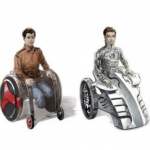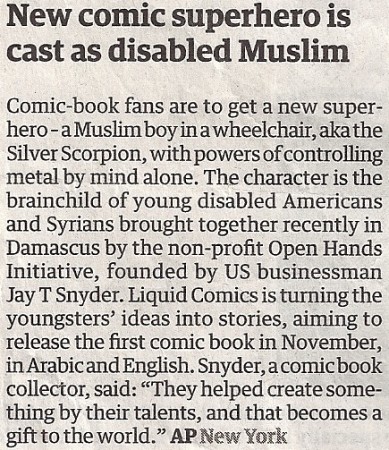 Last week, I noticed in the newspaper that a new superhero is coming to US bookstores. The Silver Scorpion, a Muslim boy in a wheelchair, will be arriving there in November.
Last week, I noticed in the newspaper that a new superhero is coming to US bookstores. The Silver Scorpion, a Muslim boy in a wheelchair, will be arriving there in November.
Perhaps this is indicative of a fresh more positive portrayal of disabled people. In fact, a wheelchair manufacturer I know was recently approached about having his product feature prominently in a new comic strip. It looks like he’s been beaten to it.
 In the land of fantasy, characters with disabilities are very common, but they’re almost always exclusively evil: Quasimodo or Captain Hook are two older portrayals. Then, in the movies, the list is never-ending: there’s Dr Strangelove. And every James Bond film has a baddie with a disability. Even the “perfect” Man with the Golden Gun has three nipples and a dwarf manservant! Most often, a flaw in a villain’s emotional makeup is evidenced with a physical imperfection.
In the land of fantasy, characters with disabilities are very common, but they’re almost always exclusively evil: Quasimodo or Captain Hook are two older portrayals. Then, in the movies, the list is never-ending: there’s Dr Strangelove. And every James Bond film has a baddie with a disability. Even the “perfect” Man with the Golden Gun has three nipples and a dwarf manservant! Most often, a flaw in a villain’s emotional makeup is evidenced with a physical imperfection.
But flawed characters are not limited to the past. In today’s supposedly more politically correct world, negative stereotyping persists. In Casino Royale, evil Le Chiffre has difficulty breathing, due to his asthma, and a facial scar.
By contrast, the number of make-believe figures that “just happen to have” a disability is tiny. Using the cartoon form might be a straightforward way to start.
The Silver Scorpion superhero will probably end up in many titanic fights. One of the most challenging will be fighting the negative stereotypes that prevail in today’s culture.
